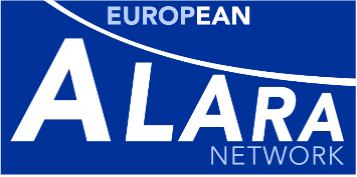In most countries, regulations are currently based on EC Directives 96/29/EURATOM for workplaces and EC recommendation 90/143/EURATOM for dwellings.
For workplaces, action levels are defined either in terms of radon concentration (Bq/m3) or in radon concentration-hours (Bq.h/m3), which take into account the duration of exposure. The range of levels varies respectively between 400 and 3000 Bq/m3 (most of the time 400 Bq/m3) and between 800 and 2000 kBq.h/m3.
For dwellings, actions levels are defined only in terms of radon concentration (Bq/m3): and range between 100 and 1000 Bq/m3 (most values are 200 or 400 Bq/m3).
In September 2009, the WHO published the WHO Handbook on Indoor Radon, which proposes new levels for managing radon in dwellings. The WHO now recommends a reference level of 100 Bq/m3 to minimize health hazards due to radon. If compliance with this level cannot be achieved, the reference level should not exceed 300 Bq/m3, which represents approximately an effective dose of 10 mSv/year.
Many countries have initiated a process to revise the regulation or recommendations, in particular after the publication of the WHO Handbook in September 2009. It is the case in Belgium, Denmark, Finland, Switzerland and the UK. Other countries, e.g. Italy, which had no regulation on radon in dwellings, after the publication of the WHO Handbook decided to start a process to set up a regulation based on the WHO recommendations.
The following table summarizes the national action levels for workplaces and dwellings.
| Country | Regulation | Action levels for workplaces | Action levels for dwellings |
| Austria | Recommendation Austrian RP Commission (1992) | Action level: 400 Bq/m3 (maximal 20 mSv/a including all NORM exposures) | Existing buildings: 400 Bq/m3 New buildings: 200 Bq/m3 |
| Armenia | Under development | ||
| Belgium | Federal RP regulation (2001) FANC radon action plan (2005) | 3 mSv/y or 800 kBq.h/m3 (compulsory) | Existing buildings: 400 Bq/m3 New buildings: 200 Bq/m3 |
| Croatia | No formal official policy defined yet | ||
| Czech Republic | Governmental decision (1999) Decree of the SONS (2002) | Action level: 1000 Bq/m3 | Existing buildings: 400 Bq/m3 New buildings: 200 Bq/m3 |
| Denmark | For dwellings: Building Code | Action level: 400 Bq/m3 | New buildings: 100 Bq/m3 Existing buildings: 100 Bq/m3 for simple remedial measures and 200 Bq/m3 for more comprehensive and costly measures |
| Finland | Decision of Min. of Social Affairs & Health 944/1992 Radiation Act 592/1991 | Action level: 400 Bq/m3 | Existing buildings: 400 Bq/m3 New buildings: 200 Bq/m3 |
| France | Public buildings: Code of Public Health (2007) Ministerial Order 07/2004 National radon action plan (2005-2008) Workplace: Ministerial Order 08/2008 Dwellings: Law (07/2009) | 400 Bq/m3 1000 Bq/m3 | Existing public buildings: 400 Bq/m3 (simple corrective actions within a 2-year time), 1000 Bq/m3 (radon diagnosis and implementation of remediation actions) New buildings: 200 Bq/m3 (recommended value) |
| Germany | Dwellings: only recommendation Workplace: legislation (RP ordinance 2001) | 2.106 Bq.h/m3 (20 mSv/y <=> 6.106 Bq.h/m3) | Voluntary action level: 100 Bq/m3 (annual mean value) |
| Greece | RP Regulations 2001 Recommendation 90/143/EURATOM | 400 Bq/m3 | Existing buildings: 400 Bq/m3 New buildings: 200 Bq/m3 |
| Ireland | RP Act, 1991 - (IR) Order 2000 (for workplaces) | 400 Bq/m3 (since 2000) | Homes (since 1990): 200 Bq/m3 Schools (since 1998): 200 Bq/m3 |
| Italy | Decree May 2000 | Workplaces: 500 Bq/m3 (annual average) NORM industries, spas and mines: 1 mSv/y of total effective dose (see full text for details) | Decided to be set-up on the basis of the WHO recommendations |
| Lithuania | HN 85:2003 | Existing buildings: 400 Bq/m3 a or 800 Bq/m3 b New buildings: 200 Bq/m3 a or 400 Bq/m3 b | Existing buildings: 400 Bq/m3 New buildings: 200 Bq/m3 |
| Slovenia | Ionizing Prot. & Nuc. Safety Act | 1000 Bq/m3 3200 Bq/m3 (category A workers) | 400 Bq/m3 Recommended value: 200 Bq/m3 |
| Spain | Royal Decree 783/2001 Specific criteria defined in 2007 | Action level for remedial actions: 400 Bq/m3 New buildings: 200 Bq/m3 | Action level for remedial actions: 400 Bq/m3 New buildings: 200 Bq/m3 |
| Sweden | Radon program since 1980 | 400 Bq/m3 | 200 Bq/m3 (existing and new buildings) |
| Switzerland | RP Ordinance June 22, 1994 | 3000 Bq/m3 | Compulsory remediation: 1000 Bq/m3 New construction and remediation programmes: 400 Bq/m3 |
| UK | Initial advice in 1987, updated in 1990 | 400 Bq/m3 (annual average) | 200 Bq/m3 (annual average) |
| .................. | currently under revision or recently revised |
a. if more than 80% of working time is spent in the building
b. if less than 80% of working time is spent in the building
